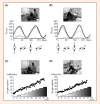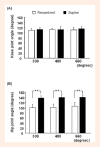Characteristics of maximum performance of pedaling exercise in recumbent and supine positions
- PMID: 24150623
- PMCID: PMC3737808
Characteristics of maximum performance of pedaling exercise in recumbent and supine positions
Abstract
To determine the characteristics of maximum pedaling performance in the recumbent and supine positions, maximum isokinetic leg muscle strength was measured in eight healthy male subjects during pedaling at three velocities (300°/s, 480°/s, and 660°/s), and maximum incremental tests were performed for each position. The maximum isokinetic muscle strength in the recumbent position was 210.0 ± 29.2 Nm at 300°/s, 158.4 ± 19.8 Nm at 480°/s, and 110.6 ± 13.2 at 660°/s. In contrast, the muscle strength in the supine position was 229.3 ± 36.7 Nm at 300°/s, 180. 7 ± 20.3 Nm at 480°/s, and 129.6 ± 14.0 Nm at 660°/s. Thus, the maximum isokinetic muscle strength showed significantly higher values in the supine position than in the recumbent position at all angular velocities. The knee and hip joint angles were measured at peak torque using a goniometer; the knee joint angle was not significantly different between both positions, whereas the hip joint angle was greater in the supine position than in the recumbent position (Supine position: 137.3 ± 9. 33 degree at 300°/s, 140.0 ± 11.13 degrees at 480°/s, and 141.0 ± 9.61 degrees at 660°/s. Recumbent position: 99.5 ± 12.21 degrees at 300°/s, 101.6 ± 12.29 degrees at 480°/s, and 105.8 ± 14.28 degrees at 660°/s). Peak oxygen uptake was higher in the recumbent position (50.3 ± 4.43 ml·kg(-1)·min(-1)) than in the supine position (48.7 ± 5.10 ml·kg(-1)·min(-1)). At maximum exertion, the heart rate and whole-body rate of perceived exertion (RPE) were unaffected by position, but leg muscle RPE was higher in the supine position (19.5 ± 0.53 than in the recumbent position (18.8 ± 0.71). These results suggest that the supine position is more suitable for muscle strength exertion than the recumbent position, and this may be due to different hip joint angles between the positions. On the contrary, the endurance capacity was higher in the recumbent position than in the supine position. Since leg muscle RPE was higher in the supine position than in the recumbent position, it was suggested that different burdens imposed on active muscles in both positions exerted an impact on the result of the endurance capacity. Key pointsIsokinetic maximal peak torque measured in this study during pedaling showed higher values in the supine position than in the recumbent position at all angular velocities.Maximum oxygen uptake as evaluated by maximum incremental testing showed higher values in the recumbent position than in the supine position.No significant changes in the angle of peak torque for the knee joint or hip joint were observed in either the recumbent or supine position even at an increased angular velocity. These observations indicate the effectiveness of a cycle-type muscle strength assessment device for evaluating leg muscle strength.
Keywords: Pedaling position; leg muscle strength; oxygen uptake; recumbent; supine.
Figures



Similar articles
-
Functional roles of the leg muscles when pedaling in the recumbent versus the upright position.J Biomech Eng. 2005 Apr;127(2):301-10. doi: 10.1115/1.1865192. J Biomech Eng. 2005. PMID: 15971708 Clinical Trial.
-
Knee joint strength ratios and effects of hip position in rugby players.J Strength Cond Res. 2012 Jul;26(7):1959-66. doi: 10.1519/JSC.0b013e318234eb46. J Strength Cond Res. 2012. PMID: 21912292
-
Position- and Sex-Related Differences in Sagittal and Frontal Plane Concentric Isokinetic Hip Muscle Peak Torques and Agonist-Antagonist Ratios.Int J Sports Phys Ther. 2024 Nov 2;19(11):1407-1416. doi: 10.26603/001c.124117. eCollection 2024. Int J Sports Phys Ther. 2024. PMID: 39502543 Free PMC article.
-
Effect of hip joint angle on concentric knee extension torque.J Electromyogr Kinesiol. 2017 Dec;37:141-146. doi: 10.1016/j.jelekin.2017.10.012. Epub 2017 Oct 26. J Electromyogr Kinesiol. 2017. PMID: 29101912
-
Hamstrings to quadriceps peak torque ratios diverge between sexes with increasing isokinetic angular velocity.J Sci Med Sport. 2008 Sep;11(5):452-9. doi: 10.1016/j.jsams.2007.04.009. Epub 2007 Sep 17. J Sci Med Sport. 2008. PMID: 17875402 Free PMC article. Review.
Cited by
-
The effect of body position on cardiovascular, skeletal muscle and ventilatory responses to submaximal cycling.Exp Physiol. 2025 Mar;110(3):391-400. doi: 10.1113/EP092256. Epub 2024 Dec 17. Exp Physiol. 2025. PMID: 39690888 Free PMC article.
-
Pedal cadence does not affect muscle damage to eccentric cycling performed at similar mechanical work.Front Physiol. 2023 Mar 10;14:1140359. doi: 10.3389/fphys.2023.1140359. eCollection 2023. Front Physiol. 2023. PMID: 36969610 Free PMC article.
-
Superior effects of high-intensity interval eccentric cycling training on neuromuscular adaptations with similar aerobic adaptations to concentric cycling.Eur J Appl Physiol. 2025 Aug 8. doi: 10.1007/s00421-025-05848-5. Online ahead of print. Eur J Appl Physiol. 2025. PMID: 40779199
-
Ingestion of High-Oleic Peanut Improves Endurance Performance in Healthy Individuals.Evid Based Complement Alternat Med. 2022 Mar 10;2022:3757395. doi: 10.1155/2022/3757395. eCollection 2022. Evid Based Complement Alternat Med. 2022. PMID: 35310027 Free PMC article.
-
Power Output and Efficiency During Supine, Recumbent, and Upright Cycle Ergometry.Front Sports Act Living. 2021 Jun 10;3:667564. doi: 10.3389/fspor.2021.667564. eCollection 2021. Front Sports Act Living. 2021. PMID: 34179774 Free PMC article.
References
-
- Beelen A., Sargeant A.J., Wijkhuizen F. (1994) Measurement of directional force and power during human submaximal and maximal isokinetic exercise. European Journal of Applied Physiology and Occupational Physiology 68, 177-181 - PubMed
-
- Blazevich A.J., Jenkins D. (1998) Physical performance differences between weight-trained sprinters and weight trainers. Journal of Science and Medicine in Sport 1, 12-21 - PubMed
-
- Bonzheim S.C., Franklin B.A., DeWitt C., Marks C., Goslin B., Jarski R., Dann S. (1992) Physiologic responses to recumbent versus upright cycle ergometry, and implications for exercise prescription in patients with coronary artery disease. American Journal of Cardiology 69, 40-44 - PubMed
-
- Borg G.A. (1973) Perceived exertion: a note on "history" and methods. Medicine and Science in Sports. 5, 90-93 - PubMed
LinkOut - more resources
Full Text Sources
Miscellaneous
